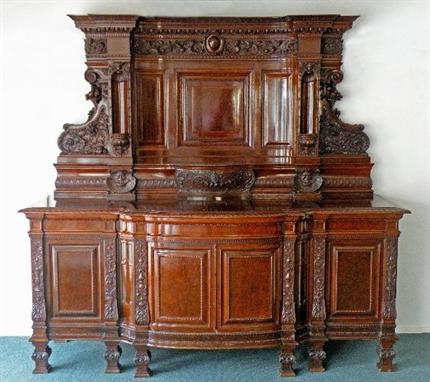A 17th Century Oak Credence Table-Cupboard of canted form. The hinged folding top opening out to form a hexagonal supported by a swing gate. The front having a rectangular cupboard door with a raised diamond centred by an elongated oval appliqué and similarly decorated panels on the canted sides, divided by split turned spindles. The large baluster legs adjoining a lower shelf raised on block feet. 31 ins (79 cms) in height, 36 ins (92 cms) in width, 19 ins (49 cms) in depth.
We found 104473 price guide item(s) matching your search
There are 104473 lots that match your search criteria. Subscribe now to get instant access to the full price guide service.
Click here to subscribe- List
- Grid
-
104473 item(s)/page
A French Empire secretaire abattant, the stepped top with a single drawer, the concave front of which bears a gilt bronze panel of a winged figure in a chariot. The fall front, beneath a single drawer, opens on to a mirrored open shelf with parcel gilt columns, gilt brass mounts and small drawers, flanked by Egyptian caryatids, width 43 1/2 ins. (See illustration)
GERMAN OAK AND MARQUETRY CABINET 18TH CENTURY inlaid throughout with scrolling foliage, the dentil cornice above a panelled frieze inlaid with script and a pair of arched panel doors inlaid with traditional figures, flanked and divided by architectural pilasters, above an multi-arched panel open shelf with five small drawers, the lower section with two further arched panel cupboard doors and three apron drawers, raised squat bun feet 206cm wide, 254cm high, 61cm deep
UNUSUAL CONTINENTAL OAK AND PINE KNEE HOLE DESK PROBABLY SWISS, 19TH CENTURY of architectural form, the parquetry veneered galleried top with an inset leather writing surface above a brushing slide and a pair of recessed panelled cupboard doors, flanked by eight small graduated drawers, opposed by a further pair of cupboard doors, each modelled as six small drawers, opening to reveal a shelf, the whole flanked and divided by brick work pilasters, raised on fluted square tapered legs 156cm wide, 81cm high, 79cm deep
A walnut sideboard, late 19th/early 20th century, the concave panelled back with open serpentine shelf flanked by heavily carved scrolling leaf corner bracket, under an egg and dart moulded frieze and leaf carved cornice, above a bow-fronted centre section flanked by a single panel cabinet door to each side, with classically carved uprights on square baluster short legs, the left hand cabinet door opening to reveal three sliding linen or glass trays (lacking the third tray), the centre and right hand side cabinet door, opening to reveal a fixed shelf, 245.5cm wide, 236cm high, 80cm deep
A figured walnut low two-tier buffet, late 19th/early 20th century, the top with serpentine front corners and gadrooned edge, over an open shelf with four panel back, and reeded baluster front and back supports, over a cabinet base on four reeded compressed bun feet, 136cm wide, 103m high, 58.5cm deep
A pair of walnut single drawer side tables, third quarter 20th century in the French taste, each with walnut quarter veneered top with gilt metal edging, over a single frieze drawer on four slender square tapering legs, united by a quarter veneered shelf stretcher (2), 49.5cm wide, 71cm high, 29.5cm deep
Vulliamy, London, No. 913. A small rosewood mantel timepiece, the dial with royal monogram, single-train fusee movement with anchor escapement, signed and numbered on the back plate, with an arched silvered dial signed Vulliamy London at 12 o`clock, pendulum rise and fall adjustment within the XII numeral, blued steel spade handles, the lower dial section engraved with the monogram of King George IV with the inscription "Commander in Chief," in a chamfer top case with silvered sight ring, reeded band and brass inlaid canted corners and base, raised on adjustable brass acorn feet, 8in (20.5cm) high. No.913 is recorded in the Vulliamy records as `Small Spring time piece in rose wood case for the Horse Guards`. The movement supplied by Holmden and lists various workers for the case, engraving, a bracket shelf (now missing), silvering and examining. The timepiece was `Sent to the Horseguards by order of Col Stephenson July 16th 1826`. The Commander in Chief in 1826 was Field Marshall Prince Frederick, Duke of York. The Duke of Wellington took over the following year, 1827. It is possible that the clock may have been a leaving present to the Duke of York from the Horse Guards staff. We are most grateful to the British Horological Institute for their assistance in cataloguing this lot.
George III Irish mahogany sideboard with raised shaped back with floral rosette decoration, shelf with turned supports, breakfront with central drawer and kneehole drawer below flanked by two deep drawers with crossbanded decoration and original brass ring handles on turned and spiral twist legs terminating on paw feet, 150cm wide
FURNITURE - AN EARLY 20TH CENTURY MAHOGANY DISPLAY CABINET ON STAND, the upper section having a carved and dentil pediment over twin glazed doors with book shelf interior, mounted on a matching stand base, raised on four squared tapered and carved legs with talo - n and ball feet and castors, 2m high x 97cm wide
FURNITURE - A VICTORIAN ROSEWOOD AND MULTI-INLAID DISPLAY CABINET having an upper section with moulded inverted and canted top over an arrangement of cubby holes and plate glass doors, mounted on a matching base with drawer and carved panel door, and flank plate - d glazed doors, shelf stretcher and four turned front feet, drawer stamped 6446, 1.96m high x 1.7m wide
A late Regency rosewood and brass strung chiffonier, the shelved superstructure on slender turned and ringed supports above a cushion drawer and two brass latticeworked cupboard doors enclosing a shelf flanked by gilt brass capped tapering turned pillars to scroll feet, 99 cm wide (ILLUSTRATED)
-
104473 item(s)/page


























